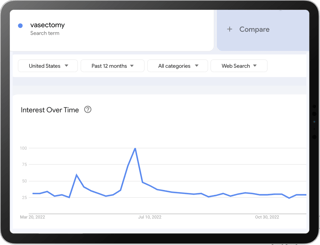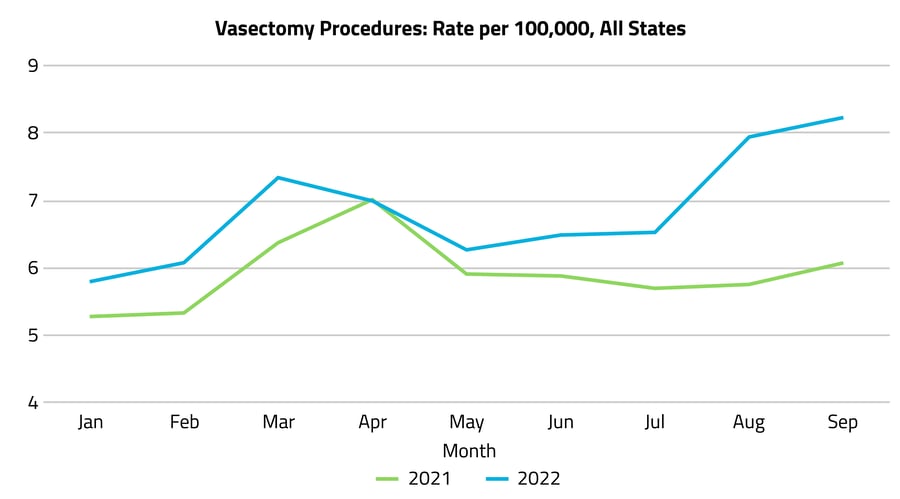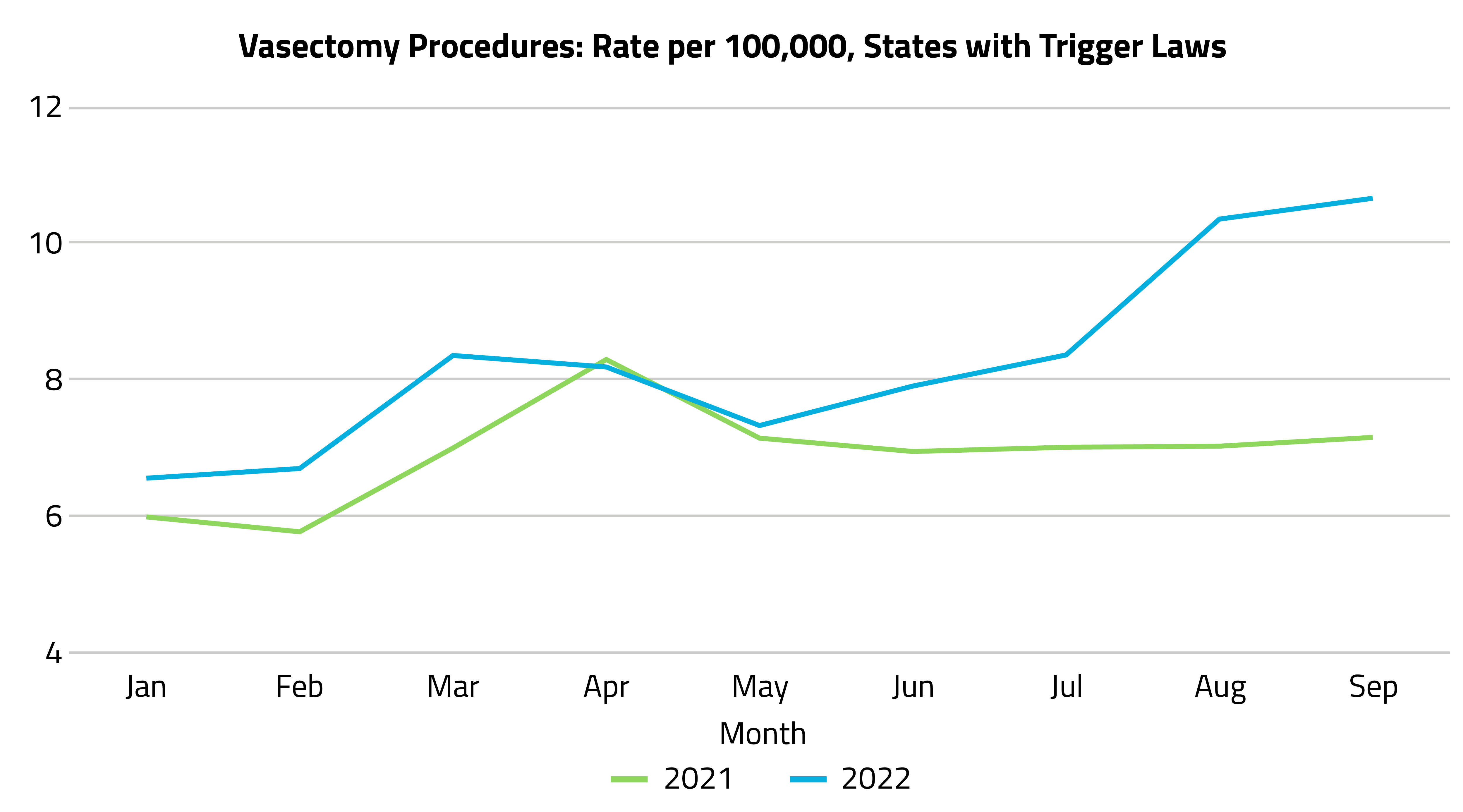Permanent Contraception and Restrictive Abortion Laws: Trends in Vasectomies After the Overturn of Roe v. Wade

When the U.S. Supreme Court’s Dobbs v. Jackson ruling overturned Roe v. Wade, the Constitutional right to abortion care was reversed, and decisions on abortion laws were left up to individual states. In 11 so-called trigger law states, abortion bans immediately took effect, and other states have followed suit. Abortion is now banned in 13 states, and other states have imposed significant restrictions. Additionally, providers in some locations have stopped or limited abortion services due to legal uncertainty. Consequently, many women of childbearing age are reconsidering their contraceptive choices, with a rising demand for long-acting contraceptive methods: a TIME-Harris poll found that 21% of women switched their birth control after the Dobbs decision, and Planned Parenthood reported a 41% increase in appointments for intrauterine devices.
For men, contraceptive options are limited. While promising drugs are in the pipeline, vasectomy remains the only available option beyond condoms. The surgical procedure carries very low risk, is typically performed as an outpatient procedure under local anesthesia, and is often covered by insurance. While both vasectomies and tubal ligations (the permanent contraceptive surgery in women) are over 99% effective, vasectomies actually fail much less often, with an estimated
1-in-2,000 failure rate compared with 1-in-100 for tubal ligation, according to Planned Parenthood.
 Internet searches for vasectomies skyrocketed after news broke that the Supreme Court was set to overturn Roe v. Wade. To explore whether these surges in interest translated into action, we used the Komodo Health™ platform to compare rates of vasectomy procedures before and after the Dobbs ruling. We analyzed the number of unique patients who underwent a vasectomy procedure or a consultation for a vasectomy procedure between January 1 and September 30, 2022, and compared this to the number seen during the same months in 2021. We included both traditional vasectomies and vas clips. For comparison, we also looked for trends in patients with consultations and procedures for tubal ligation.
Internet searches for vasectomies skyrocketed after news broke that the Supreme Court was set to overturn Roe v. Wade. To explore whether these surges in interest translated into action, we used the Komodo Health™ platform to compare rates of vasectomy procedures before and after the Dobbs ruling. We analyzed the number of unique patients who underwent a vasectomy procedure or a consultation for a vasectomy procedure between January 1 and September 30, 2022, and compared this to the number seen during the same months in 2021. We included both traditional vasectomies and vas clips. For comparison, we also looked for trends in patients with consultations and procedures for tubal ligation.
Here’s what we found:
In the immediate aftermath of the Roe v. Wade overturn, vasectomies increased by 30%.
Nationwide, vasectomy procedures increased by 30% from July through September 2022 compared with the same time period in 2021. Additionally, men’s contraceptive consultations increased by 18% from May through September 2022 compared to the same period in 2021, signaling both increased interest as well as a higher rate of follow-through for men seeking vasectomies after Roe v. Wade was overturned. The media leak of the upcoming Supreme Court decision may have contributed to the increase in consultations in the month prior to the Dobbs decision.

Vasectomies increased by 39% in states with restrictive trigger laws — higher than the national average.
Greater increases in vasectomies were seen in states with trigger laws. Among the 11 states that made abortion illegal immediately after Dobbs,* vasectomies increased by 39% between July and September 2022 compared to the same time period in 2021. Men's contraceptive consultations in these states increased by 33% from May through September compared with the same time period in 2021.

Rates of tubal ligations remained steady.
Rates of tubal ligation procedures were similar in May-Sept of 2022 compared with the same period in 2021, with an average of 3 procedures per 100,000 patients in both 2021 and 2022. This could be due to various factors, including other effective contraceptive options available to women that are less invasive, less expensive, and reversible (e.g., Planned Parenthood reported a 41% increase in appointments for intrauterine devices). Rates of contraceptive consultations for female patients also remained consistent, with 60 consultations per 100,000 patients during the May-Sept time period in 2021 and 2022.
Significantly more consultations for contraception advice took place for female patients compared with male patients in both years. This likely reflects the standard provider discussions built into gynecological care for pregnant women and women avoiding pregnancy. Interestingly, in 2021, there were 8 times as many consultations for women than for men, and in 2022, there were 6 times as many. This likely reflects the increase in vasectomy demand that we’ve observed in this analysis.
This analysis underscores the impact of restricting comprehensive healthcare access on the lives and decisions of Americans of all backgrounds. As we’ve shown, the immediate behavioral impact of abortion restrictions extends beyond women alone; men are also reconsidering their own role in pregnancy-prevention strategies.
The ripple effects of this policy change have been profound and will continue to play out. A report by the Commonwealth Fund found that states with highly restrictive abortion laws in 2020 had maternal death rates that were 62% higher than states with broader access. Highly restrictive abortion laws are associated with decreases in maternity care provision and increase in maternity care deserts, unsafe abortion, maternal and infant injury and mortality, and racial inequity in healthcare. The ramifications of abortion restrictions tend to fall most heavily on low-income individuals and people of color.
At Komodo Health, our full-stack technology platform puts us in a unique position to identify the consequences of changes in access to healthcare. In our mission to reduce the burden of disease, we are committed to shedding light on the broad impact of the Dobbs decision as it unfolds, including the inherent disparities that will likely continue to grow in its wake.
*Alabama, Arkansas, Idaho, Kentucky, Louisiana, Mississippi, Missouri, Oklahoma, South Dakota, Tennessee, and Texas
Read our Founders' message on the importance of access to reproductive healthcare in 2022. Or check out another county- and state-level analysis on trends in metastatic breast cancer.
To see more articles like this, follow Komodo Health on Twitter, LinkedIn, or YouTube, and visit Insights on our website.







